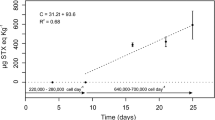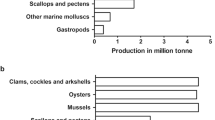Abstract
Domoic acid (DA), the amnesic shellfish toxin, is a food-web-transferred algal toxin that has been detected in many marine organisms from copepods to whales. However, cephalopods, which are important members of the food chain, have never been implicated in DA transfer or accumulation. Here, we present data showing relevant values of DA detected in the common octopus (Octopus vulgaris) from the Portuguese continental coast. Even though DA is hydrophilic and is not expected to be accumulated in the tissues, DA was always detected in our octopus tissue samples. Tissue distribution of DA revealed that the digestive gland and the branchial hearts are the main organs of DA accumulation. Highly variable DA concentrations, ranging from 1.1 to 166.2 μg DA g−1, were observed in the digestive glands. Low levels of DA were detected in the digestive tract (stomach and intestine) and could be a consequence of high digestion rates or a result of non-exposure to toxic vectors during the sampling period. In fact, octopus prey, such as bivalves, crustaceans and fishes, are known to occasionally work as DA vectors. Consequently, DA uptake into octopus tissues is likely sporadic. Similar low levels were detected in the kidney, gills, systemic heart, posterior salivary glands and mantle, and no DA was found in either the gonads or the ink sac. These data are the necessary first step towards achieving an understanding of the accumulation of phycotoxins in O. vulgaris.




Similar content being viewed by others
References
Altman JS (1967) The behaviour of Octopus vulgaris Lam, in its natural habitat: a pilot study. Underw Assoc Rep 1966/1967:77–83
Altwein DM, Foster K, Doose G, Newton RT (1995) The detection and distribution of the marine neurotoxin domoic acid on the Pacific Coast of the United States 1991–1993. J Shellfish Res 14:217–222
Ambrose RF, Nelson BV (1983) Predation by Octopus vulgaris in the Mediterranean. Mar Ecol 4:251–261
Arévalo FF, Bermúdez M, Salgado C (1998) ASP toxicity in scallops: individual variability and tissue distribution. In: Reguera B, Blanco J, Fernández ML, Wyatt T (eds) Harmful algae. Xunta de Galicia and the IOC of UNESCO, Paris, pp 499–502
Bargu S, Powell CL, Coale SL, Busman M, Doucette GJ, Silver MW (2002) Krill: a potential vector for domoic acid in marine food webs. Mar Ecol Prog Ser 237:209–216
Bargu S, Marinovic B, Mansergh S, Silver MW (2003) Feeding responses of krill to the toxin-producing diatom Pseudo-nitzschia. J Exp Mar Biol Ecol 284:87–104
Bates SS, Bird CJ, de Freitas ASW, Foxall R, Gilgan M, Hanic LA, Johnson GR, McCulloch AW, Odense P, Pocklington R, Quilliam MA, Sim PG, Smith JC, Subba Rao DV, Todd ECD, Walter JA, Wright JLC (1989) Pennate diatom Nitzschia pungens as the primary source of domoic acid, a toxin in shellfish from eastern Prince Edward Island, Canada. Can J Fish Aquat Sci 46:1203–1215
Blanco C, Salomón O, Raga JA (2001) Diet of the bottlenose dolphin (Tursiops truncatus) in the western Mediterranean Sea. J Mar Biol Assoc UK 81:1053–1058
Blanco J, Acosta CP, de la Puente MB, Salgado C (2002) Depuration and anatomical distribution of the amnesic shellfish poisoning (ASP) toxin domoic acid in the king scallop Pecten maximus. Aquat Toxicol 60:111–121
Boucaud-Camou E, Boucher-Rodoni R, Mangold K (1976) Digestive absorption in Octopus vulgaris (Cephalopoda, Octopoda). J Zool (Lond) 179:261–271
Boucher-Rodoni R, Mangold K (1977) Experimental study of digestion in Octopus vulgaris (Cephalopoda: Octopoda). J Zool (Lond) 183:505–515
Boyle P, Boletzky S (1996) Cephalopod populations: definition and dynamics. Philos Trans R Soc Lond B Biol Sci 351:985–1002
Buck KR, Uttal-Cooke L, Pilskaln CH, Roelke DL, Villac MC, Fryxell GA, Cifuentes L, Chavez FP (1992) Autecology of the diatom Pseudonitzschia australis Frenguelli, a domoic acid producer, from Monterey Bay, California. Mar Ecol Prog Ser 84:293–302
Caddy JF, Rodhouse PG (1998) Cephalopod and groundfish landings: evidence for ecological change in global fisheries. Rev Fish Biol Fishes 8:431–444
Costa PR, Rodrigues S, Botelho MJ, Sampayo MAM (2003) A potential vector of domic acid: the swimming crab Polybius henslowii Leach (Decapoda–Brachyura). Toxicon 42:135–141
Cuénot KG, Bruntz V (1908) Recherches chimiques sur les coeurs branchiaux des Céphalopodes. Démonstration du rôle excreteur des cellules qui éliminenent le carmin ammoniacal des injections physiologiques. Arch Zool Exp Gén 9 Notes Rev 3:49–53
Drum AS, Siebens TL, Crecelius EA, Elston RA (1993) Domoic acid in the Pacific razor clam Siliqua patula (Dixon, 1789). J Shellfish Res 12:443–450
Fiúza AFG, Macedo ME, Guerreiro MR (1982) Climatological space and time variation of the Portuguese coastal upwelling. Oceanol Acta 5:31–40
Fritz L, Quilliam MA, Wright JLC, Beale A, Work TM (1992) An outbreak of domoic acid poisoning attributed to the pennate diatom Pseudonitzschia australis. J Phycol 28:439–442
Garrison DL, Conrad SM, Eilers PP, Waldron EM (1992) Confirmation of domoic acid production by Pseudonitzschia australis (Bacillariophyceae) cultures. J Phycol 28:604–607
Grisley MS, Boyle PR (1988) Recognition of food in Octopus digestive tract. J Exp Mar Biol Ecol 118:7–32
Guerra A (1978) Sobre la alimentación y el compartimiento alimentario de Octopus vulgaris. Investig Pesq 42:351–364
Horner RA, Kusske MB, Moynihan BP, Skinner RN, Wekell JC (1993) Retention of domoic acid by Pacific razor clams, Siliqua patula (Dixon, 1789): preliminary study. J Shellfish Res 12:451–456
Lefebvre KA, Powell CL, Busman M, Doucette GJ, Moeller PDR, Silver JB, Miller PE, Hughes MP, Singaram S, Silver MW, Tjeerdema RS (1999) Detection of domoic acid in northern anchovies and California sea lions associated with an unusual mortality event. Nat Toxins 7:85–92
Lefebvre KA, Dovel SL, Silver MW (2001) Tissue distribution and neurotoxic effects of domoic acid in a prominent vector species, the northern anchovy Engraulis mordax. Mar Biol 138:693–700
Lefebvre KA, Silver MW, Coale SL, Tjeerdema RS (2002a) Domoic acid in planktivorous fish in relation to toxic Pseudo-nitzschia cell densities. Mar Biol 140:625–631
Lefebvre KA, Bargu S, Kieckhefer T, Silver M (2002b) From sanddabs to blue whales: the pervasiveness of domoic acid. Toxicon 40:971–977
Lincoln JA, Turner JT, Bates SS, Léger C, Gauthier DA (2001) Feeding, egg production and egg hatching success of the copepods Acartia tonsa and Temora longicornis on diets of the toxic diatom Pseudo-nitzschia multiseries and the non-toxic diatom Pseudo-nitzschia pungens. Hydrobiologia 453:107–120
Mangold K (1998) The Octopodinae from the eastern Atlantic Ocean and the Mediterranean Sea. In: Voss NA, Vecchione M, Toll RB, Sweeney MJ (eds) Systematics and biogeography of cephalopods, vol 1. Smithson Contrib Zool 586:521–528
Martin AW, Aldrich FA (1970) Comparison of hearts and branchial heart appendages in some cephalopods. Can J Zool 48:751–758
Miramand P, Guary JC (1980) High concentrations of some heavy metals in tissues of the Mediterranean octopus. Bull Environ Contam Toxicol 24:783–788
Nakahara M, Shimizu C (1985) Cobalt-binding substances in the branchial heart of Octopus vulgaris. Bull Jpn Soc Sci Fish 51:1195–1199
Nakahara M, Koyanagi T, Ueda T, Shimizu C (1979) Peculiar accumulation of cobalt-60 by the branchial heart of Octopus. Bull Jpn Soc Sci Fish 45:539
Nigmatullin CM, Ostapenko A (1976) Feeding of Octopus vulgaris Lam, from the Northwest African coast. Int Counc Explor Sea Comm Meet (Shellfish and Benthos Comm) 1976/K6:1–15
Nixon M (1987) Cephalopod diets. In: Boyle PR (eds) Cephalopod life cycles: comparative reviews, vol II. Academic, London, pp 201–220
Novaczek I, Madhyastha MS, Ablett RF, Johnson G, Nijjar MS, Sims DE (1991) Uptake, disposition and depuration of domoic acid by blue mussels (Mytilus edulis). Aquat Toxicol 21:103–118
Piatkowski U, Pierce GJ, Cunha MM (2001) Impact of cephalopods in the food chain and their interaction with the environment and fisheries: an overview. Fish Res (Amst) 52:2–10
Quilliam MA, Wright JLC (1989) The amnesic shellfish poisoning mystery. Anal Chem 61:1053A–1060A
Quilliam MA, Xie M, Hardstaff WR (1995) Rapid extraction and cleanup for liquid chromatographic determination of domoic acid in unsalted seafood. J AOAC (Assoc Off Anal Chem) Int 78:543–554
Rosa R, Marques AM, Nunes ML, Bandarra N, Sousa Reis C (2004) Spatial–temporal changes in dimethyl acetal (octadecanal) levels of Octopus vulgaris (Mollusca, Cephalopoda): relation to feeding ecology. Sci Mar (in press)
Sánchez P, Obarti R (1993) The biology and fishery of Octopus vulgaris caught with clay pots on the Spanish Mediterranean coast. In: Okutani T, O’Dor RK, Kubodera T (eds) Recent advances in cephalopod fisheries biology. Tokai University Press, Tokyo, pp 477–487
Santos RA, Haimovici M (2001) Cephalopods in the diet of marine mammals stranded or incidently caught along southeastern and southern Brazil (21–34°S). Fish Res (Amst) 52:99–112
Schipp R, Hevert F (1981) Ultrafiltration in the branchial heart appendage of dibranchiate cephalopods: a comparative ultrastructural and physiological study. J Exp Biol 92:23–35
Scholin CA, Gulland F, Doucette GJ, Benson S, Busman M, Chavez FP, Cordaro J, DeLong R, De Vogelaere A, Harvey J, Haulena M, Lefebvre K, Lipscomb T, Loscutoff S, Lowenstine LJ, Martin RI, Miller PE, McLellan WA, Moeller PDR, Powell CL, Rowles T, Silvagnl P, Silver M, Spraker T, Trainer V, Van Dolah FM (2000) Mortality of sea lions along the central California coast linked to a toxic diatom bloom. Nature 403:80–84
Sierra Beltrán A, Palafox-Uribe M, Grajales-Montiel J, Cruz-Villacorta A, Ochoa JL (1997) Sea bird mortality at Cabo San Lucas, Mexico: evidence that toxic diatom blooms are spreading. Toxicon 35:447–453
Smale MJ, Buchan PR (1981) Biology of Octopus vulgaris off the east coast of South Africa. Mar Biol 65:1–12
Subba Rao DV, Quilliam MA, Pocklington R (1988) Domoic acid—a neurotoxic amino acid produced by the marine diatom Nitzschia pungens in culture. Can J Fish Aquat Sci 45:2076–2079
Summers WC (1983) Physiological and trophic ecology of cephalopods. In: Russel-Hunter WD (eds) The Mollusca, vol 6. Academic, New York, pp 261–279
Tester PA, Pan Y, Doucette GJ, Scholin CA (2001) Accumulation of domoic acid activity in copepods. In: Hallegraeff GM, Blackburn SI, Bolch CJ, Lewis RJ (eds) Harmful algal blooms 2000. Intergovernmental Oceanographic Commission of UNESCO, Paris, pp 418–421
Todd ECD (1993) Domoic acid and amnesic shellfish poisoning—a review. J Food Prot 56:69–83
Vale P, Sampayo MAM (2001) Domoic acid in Portuguese shellfish and fish. Toxicon 39:893–904
Wekell JC, Gauglitz EJ Jr, Barnett HJ, Hatfield CL, Eklund M (1994) The occurrence of domoic acid in razor clams (Siliqua patula), Dungeness crab (Cancer magister), and anchovies (Engraulis mordax). J Shellfish Res 13:587–593
Wells MJ (1978) Octopus: physiology and behaviour of an advanced invertebrate. Chapman and Hall, London
Work TM, Beale AM, Fritz L, Quilliam MA, Silver M, Buck K, Wright JLC (1993) Domoic acid intoxication of brown pelicans and cormorants in Santa Cruz, California. In: Smayda TJ, Shimizu Y (eds) Toxic phytoplankton blooms in the sea. Elsevier, Amsterdam, pp 643–650
Wright JLC, Boyd RK, de Freitas ASW, Falk M, Foxall RA, Jamieson WD, Laycock MV, McCulloch AW, McInnes AG, Odense P, Pathak V, Quilliam MA, Ragan MA, Sim PG, Thibault P, Walter JA, Gilgan M, Richard DJA, Dewar D (1989) Identification of domoic acid, a neuroexcitatory amino acid, in toxic mussels from eastern Prince Edward Island. Can J Chem 67:481–490
Acknowledgements
The Portuguese Foundation for Science and Technology (FCT) supported this study through a doctoral grant to the first author. Gratitude is due to P. da Conceição for his technical assistance and to Dr. J. Pereira for his help obtaining the specimens. We are indebted to Dr. P. Vale for his assistance with the LC-MS analysis.
Author information
Authors and Affiliations
Corresponding author
Additional information
Communicated by S.A. Poulet, Roscoff
Rights and permissions
About this article
Cite this article
Costa, P.R., Rosa, R. & Sampayo, M.A.M. Tissue distribution of the amnesic shellfish toxin, domoic acid, in Octopus vulgaris from the Portuguese coast. Marine Biology 144, 971–976 (2004). https://doi.org/10.1007/s00227-003-1258-6
Received:
Accepted:
Published:
Issue Date:
DOI: https://doi.org/10.1007/s00227-003-1258-6




